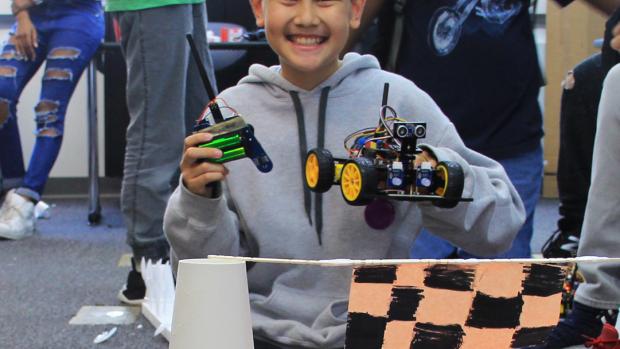At the CrEST of Something Big
Innovation abounds at this summer's CrEST program for high school students

From a smart chair that eliminates the need for a remote control to a nightlight that also serves as a smoke alarm and carbon monoxide detector, students who took park in this summer’s CrEST program at the NYU Tandon School of Engineering’s Center for K12 STEM Education came up with several useful and innovative products.
This summer’s CrEST (Creativity in Engineering, Science, and Technology) program ran for four weeks and was aimed at teaching high school students physical computing, mechanical systems, and electronics; by the time they were done, each had designed and built his or her own interactive device, which was then displayed at an end-of-summer expo. (Ben Esner, the Center’s director, stresses that special thanks are due to partners at ExpandED Schools, The Pinkerton Foundation and Ultimaker for making CrEST possible.)
Filling a need for athletes, Viva Paintsil of Brooklyn Collegiate embedded force sensors into a pair of gloves, which will allow boxers and practitioners of other contact sports to be notified if they are in danger of causing their opponents real physical harm. Other CrEST participants focused more on fulfilling the human need for fun. Kami Roberts, a student from Brooklyn’s Boys and Girls High School, made a high-tech version of a Magic 8-Ball, a popular novelty from decades past that displayed an answer to a yes or no question. (When asked if Kami might one day become an engineer, the LCD device gave a quick affirmative answer.)
Another game drawing a crowd was designed by Caitlyn Tsang, a Midwood student who had been introduced to CrEST by her robotics teacher and who had trained throughout the school year so that she could serve as a peer instructor during the summer. (One of the unique components of CrEST is that students who put in time during the school year can serve as instructors over the summer, and summer participants can later lead CrEST workshops for middle school students.) Caitlyn’s game involved tapping a button as quickly as possible within a short timeframe — simple but highly addictive.
Addressing the issue of other addictive pursuits, Rana Mohamed, also of Midwood, created a wearable device that can be activated before starting a study session. If the user picks up his or her cell phone while the device is activated, an alarm sounds — signaling them to drop the phone and return immediately to their studies.
Eugene Thomas, a rising junior at Stuyvesant High School, was the creator of that smart chair, which turns on a television or other entertainment option as soon as the user sits. “Right now, I’m just using an ordinary desk chair,” he explained, “but I could see my device being applied to any style or variety of seating.” Does a student from a high school as notoriously challenging as Stuyvesant even have time to watch television? “I do sometimes,” he admits, “and I don’t want to waste any of my screen time searching for a lost remote.”
Other student projects addressed admittedly more serious issues. On display was a colorful butterfly-shaped nightlight that would flash wildly in the presence of carbon monoxide or smoke. “Because of its design it’s especially suitable for a child’s room,” its creator, Jenny Liu from the High School for Dual Language and Asian Studies, said. “Smoke alarms are important, but most are not designed to be especially attractive, so this could be a popular product.”
Not every project involved electronics. “We discovered that we had a talent for design,” Deja Singleton and Shuran Rathour, explained. The girls put that shared talent to use by collaborating on a 3D-printed speaker that can amplify the music from a cell phone. “We took acoustics into account when we designed it, and it works very well, so we’re hoping to be able to mass-produce them one day — maybe when Tandon opens its new MakerSpace,” they said.
They were far from the only students dreaming of NYU Tandon’s resources and reputation. Enrique Pena, who now attends Pan American International High School in Queens, had heard about Tandon back in his native Peru. “This has been my dream school for a while,” he asserted, “so to be here over the summer, working with things like Arduinos and LCDs for the first time was very exciting.”

See more projects on the Center’s Facebook Page or visit the CrEST collection on YouMagine.




